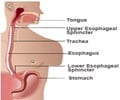Diagnosis
Tests used to diagnose
- Blood tests: Blood tests show a rise in gastrin levels. However, other conditions can also result in increased gastrin levels; thus the test used alone is not diagnostic of gastrinoma.
- In a normal human being, fasting gastrin levels are less than 150 pg/mL. Gastrinoma patients usually have a gastrin level more than 150–200 pg/mL. Levels of gastrin are obtained with patients not taking H2-receptor antagonists for 24 hours or proton pump inhibitors for 6 days. These are the drugs commonly prescribed for ulcer disease.
- Gastric acid measurements: Gastric acid measurements may be done to check for acid hypersecretion. In case this is not possible, the basal gastric pH is measured. A basal gastric pH greater than or equal to 3 excludes gastrinomas.
- Secretin test: In the secretin test, basal gastrin concentration is first measured with a blood test. Secretin is then injected into a vein and samples at regular intervals are collected for up to a duration of 30 minutes. An increase of plasma gastrin levels of over 200 pg/mL within 2–30 minutes is seen in 85% of patients with gastrinoma.
- Imaging studies: Imaging studies are required to locate the gastrinomas and evaluate their stage. An important imaging study in this context is the somatostatin receptor scintigraphy (SRS) using 111In-pentetreotide with single photon emission tomography (SPECT) scanning. Endoscopic ultrasound, CT scan and MRI may also be used.
- Functional studies: Functional studies that measure hormone gradients by transhepatic portal venous sampling may also be used.





